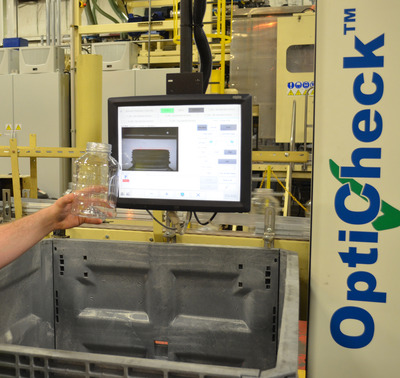Control equipment addresses multiple blow-moulding challenges
Wednesday, 22 January, 2014
With a gap as short as 15 minutes between blowing and filling a PET bottle, producing containers of consistent quality is imperative. Container defects can cause serious and costly disruptions that can have a knock-on effect through the entire processing plant.
When two different types of PET containers - such as standard beverage bottles and wide-mouth jars - are fabricated on the same machine, the complexity of the blow-moulding process intensifies.
Blow-moulded plastic container manufacturer Graham Packaging Co addressed these challenges with the help of Agr International’s Process Pilot Automated Blowmolder Control System and the OptiCheck vision-based inspection and measurement system.
Installed in the blow moulder, the Process Pilot uses a combination of powerful software and high-accuracy sensors to proactively manage material distribution throughout the container. Downstream, the OptiCheck ensures that all output meets specifications before entering the filling line.

The OptiCheck in action.
Graham makes two types of containers with different finish diameters: a 43 mm finish for the bottles and 63 to 83 mm for the jars. At first, the company thought that producing both types on a single Sidel blow moulder with a spindle diameter of 43 mm was impossible.
However, the manufacturer developed an economical approach that adapts to each format by deploying its proprietary blow-trim technology. In the blow-trim process, custom moulds inserted inside the blow moulder shape the wide-mouth jars out of 43 mm diameter preforms. Instead of using the threads of the original preform, the mould forms a new set of jar threads at a point along the preform side wall. In a secondary process, the portion of the jar above the newly blown threads - the moil, or excess area - is cut off by a trimmer downstream and recycled.
According to David Piccioli, director, Global PET Technology Development for Graham, the blow-trim process is more challenging than traditional reheat stretch blow moulding. “It is much more difficult to control the blown finish,” he notes.
The difficulty lies in attaining the right material distribution in the body and thickness in the thread region, a task for which the Process Pilot is suited. Its thickness gauge sensors measure 16 different points on the side wall around the perimeter of the bottle. Sophisticated algorithms analyse minute changes in material distribution.
If there are any deviations from specifications, the Process Pilot automatically corrects the corresponding area of the blow moulder. Working in conjunction with the blow-moulder controls, the system can simultaneously adjust multiple settings - lamps, blow pressure and timing, for example - to maintain tight process control parameters with minimal operator intervention.
Because jar finish is so critical to protect product integrity, the containers go through one final inspection step before being conveyed through the wall to the filling plant. Graham personnel view the Agr OptiCheck, a compact inspection and measurement system, as their ‘last line of defence’. The OptiCheck’s finish gauging module uses a proprietary configuration of multiple cameras, LED-based backlighting and high-speed imaging to measure critical container dimensions inline to an accuracy of 0.0508 mm. The system’s image analysis algorithms accurately identify flaws and blemishes, such as whiskers left from trimming, rejecting jars that could pose seal surface-related problems.
The cost-effective blow-trim approach offers multiple benefits for the container manufacturer. Fabricating the wide-mouth jars from standard preforms eliminates the need for special handling equipment and a dedicated blow moulder with larger spindles. The jar line is able to run at normal production speeds, in sync with the filling line, making the customised containers very competitive.
Automated management of material distribution overcomes many potential container issues, whether relating to operator inexperience, preform variability or environmental influences. Precisely controlling the blow-moulding process ensures that every jar and bottle can be sealed to protect the integrity of its contents.
In the 12 months following the installation of the Process Pilot, the bottle plant experienced a 52.7% improvement in waste reduction. Looking at all the benefits, including enhanced productivity and the savings in raw material due to consistent output, the payback period for the new system was less than one year.
The operation has seen a big improvement in Cpks and Ppks since the Process Pilot and OptiCheck were installed on the blow-trim line, observes Graham Plant Manager Don Waud.
“Our productivity and customer satisfaction have increased, and we don’t run our jar line without them,” Waud concludes.
Six beverage trends predicted for 2026
Demand for customisation, 'protein-ification' and sustainable storytelling are some of...
Making UHT processing less intensive on energy
A nutritional beverages company was seeking a more sustainable way to produce UHT beverages using...
Tasty twist for chocolate alternatives
Food scientists develop two novel flavour-boosting techniques to transform carob pulp into a...











